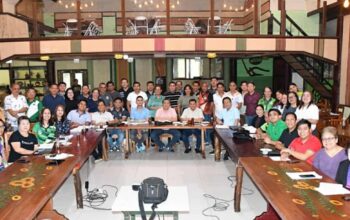AS far as this year’s target for the National Greening Program (NGP), Bohol has accomplished 100% in terms of plantation establishment, but then, the extreme heat in the past weeks have posed a real threat to the greening program.
But that is no reasons why we have to stop planting.
Thus says Forested Maria Lorena Castino, NGP Coordinator for Bohol, during the recent Kapihan sa PIA, aired live over DyTR and streamed online at PIA Bohol facebook page.
Castino, along with the Department of Environment and Natural Resources Officer in charge for Conservation and Development Section Foresters Marcial Ugay and NGP Forest extension Officer Juliet Tadle said the extreme climates in the past months have impacted on the survival of the newly planted seedlings.
Ironically, the National Government adopts the tree plantation establishment to help delay the effects of the changing climate which has brought the drought in times when the southeast monsoon would have been dumping rains.
A bush fire also hit sections of the NGP plantation in Candijay last week, raising concerns of replanting in areas where the DENR has already paid for the contracted group planting and nurturing the trees.
During the Kapihan, forester Castino said from 2011 during the sprouting of the NGP which initially plans to plant 1.5 billion trees in 1.5 million hectares, Bohol has a target of 32,378 hectares of vegetative cover to restore.
This year, Bohol has a target of 1,117 hectares to replant and forests to reclaim, majority of which is focused on the grass covered hills of CENRO Talibon.
And while CENRO Tagbilaran has already a largely well covered area except for the built-up areas, CENRO Talibon owns up to 815 hectares of plantation this year, which it filled with timber, rattan, bamboo and mangroves.
CENRO Tagbilaran’s target, some 302 hectares are already accomplished, Castino reported.
Despite the target, the DENR here is lucky even as other groups have put up their own tree-planting projects.
The Diocese of Tagbilaran has a continuing program, and is on to yet nature-nurture activities in response to the call of the Seasons of Creation.
While most coordinate with the DENR for their tree planting activities, Ugay advised groups to get fruit bearing trees instead of the usual exotic species that do not blend well with environment.
Tugas, even when regulated is always better than mahogany and gmelina, all you need to do is register it, and after it will mature, one can harvest it.
Indigenous native species, suggests Ugay, who also echoed the DENR Bohol policy on preferences for fruit bearing and trees that give food.
With fruit bearing trees, birds feed on them, and when they do, they carry the seeds elsewhere, naturally dispersing them and spreading the biodiversity, according to the forester.
As for the seedlings, aside from the DENR nurseries that are scattered in some strategic locations in Bohol, a facility owned by the Provincial Government in the Bohol Biodiversity Complex in Bilar town.
Created as a consequence of the Bohol Environment Ordinance, Bohol Biodiversity Complex is a center dedicated to the study and propagation of Bohol’s endemic tree species, has an extensive dipterocarp nursery and a seed bank that has an impressive inventory of native tree species as needed.
Seedlings and planting materials are available, just coordinate with the DENR or Bohol Provincial Environment Management Office, which has the BDC under its supervision. (RAHC/PIA-7/Bohol)


